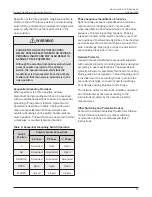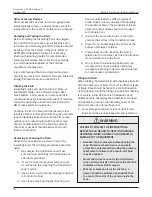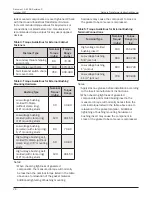
Document 2.4.128, Revision 3
October, 2017
19
Network Transformer Instruction Manual
Air Test Provision
The air test provision is located on the primary switch
chamber above the 85
°
C fluid level. The provision
consists of a 0.5-inch NPT opening with protective
plug, which can be used for testing the air inside the
switch chamber.
Automatic Pressure Relief Valve and Pressure Relief
Device
The automatic pressure relief valve (PRV) is designed
to relieve excessive tank pressures that might occur
during operation of the transformer. The standard
subway-type PRV consists of a self-resealing, spring-
loaded diaphragm and is normally located above the
fluid level on the side of the transformer main tank.
The PRV can be operated manually by pulling on the
pull-ring with a live-line tool. An optional high flow-
rate pressure relief device (PRD) is supplied when
specified, and mounted on the transformer main
tank cover. The high flow-rate PRD can be supplied
with optional switch contacts, which can be used to
provide a remote indication of valve activation.
When gas pressure in the tank exceeds the PRV’s or
PRD’s specified limit, the gas pressure will cause the
valve to open, venting the excess pressure. After the
internal pressure decreases below the PRV or PRD
reseal rating, the valve will automatically close and
reseal the transformer.
WARNING
FAILURE TO FOLLOW THE INSTRUCTIONS
BELOW COULD RESULT IN DEATH OR
SERIOUS PERSONAL INJURY AND MAY
ALSO
RESULT IN DAMAGE TO THE EQUIPMENT.
• The cause of PRV or PRD activation should
always be investigated, since pressure
venting indicates a potential problem
inside the transformer.
• Personnel should wear eye and skin
protective equipment when using the PRV
to relieve tank pressure. Hot fluid may be
expelled.
• Do not attempt to disassemble a PRD.
Internal components may be under high
spring pressure, creating a potential
hazard from flying objects.
Primary Entrance
The primary entrance is located on the top of the
terminal chamber and is provided for connection to
the primary feeders. The primary entrance typically
consists of separable insulated connectors, wiping
sleeves or potheads, as specified by the user.
When separable insulated connectors are provided,
they may consist of universal bushing wells only,
universal busing wells with factory-installed bushing
inserts, or one-piece bushings. In the case of
separable insulated connectors, a single chamber is
provided to house the terminals and primary switch,
unless a separate terminal chamber is specified
by the user. When a separate terminal chamber is
provided, it is filled with fluid at the factory and need
not be opened in the field. Installation of bushing
inserts and primary feeder cables should be carried
out in accordance with instructions provided by the
bushing manufacturer.
When wiping sleeves or potheads are provided,
primary feeder connections will be made inside the
terminal chamber. In this case, terminal chambers
are shipped dry, and must be filled with the proper
insulating fluid or compound after connections are
made and the chamber cover has been properly
installed. Refer to the cable manufacturer’s
instructions for proper method of cable connection,
use of stress cones and selection of insulating fluid
or compound. When filling with compound, voids
must be prevented, otherwise partial discharge
issues and cable failure could result. Consult
compound manufacturer for recommended filling
temperature and technique.
High-Voltage Bushings
Externally-removable high-voltage bushings are
installed between the main tank and the primary
switch chamber. These bushings can be removed
and replaced through the switch chamber. When
replacing bushings, new gaskets should be used.
When a separate terminal chamber is provided,
externally-removable bushings are also installed
between the primary switch chamber and the
terminal chamber. These bushings can be removed
and replaced from the terminal chamber. When
replacing these bushings, new gaskets should be
used.










































